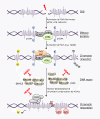Dietary phytochemicals, HDAC inhibition, and DNA damage/repair defects in cancer cells
- PMID: 22247744
- PMCID: PMC3255482
- DOI: 10.1186/1868-7083-3-4
Dietary phytochemicals, HDAC inhibition, and DNA damage/repair defects in cancer cells
Abstract
Genomic instability is a common feature of cancer etiology. This provides an avenue for therapeutic intervention, since cancer cells are more susceptible than normal cells to DNA damaging agents. However, there is growing evidence that the epigenetic mechanisms that impact DNA methylation and histone status also contribute to genomic instability. The DNA damage response, for example, is modulated by the acetylation status of histone and non-histone proteins, and by the opposing activities of histone acetyltransferase and histone deacetylase (HDAC) enzymes. Many HDACs overexpressed in cancer cells have been implicated in protecting such cells from genotoxic insults. Thus, HDAC inhibitors, in addition to unsilencing tumor suppressor genes, also can silence DNA repair pathways, inactivate non-histone proteins that are required for DNA stability, and induce reactive oxygen species and DNA double-strand breaks. This review summarizes how dietary phytochemicals that affect the epigenome also can trigger DNA damage and repair mechanisms. Where such data is available, examples are cited from studies in vitro and in vivo of polyphenols, organosulfur/organoselenium compounds, indoles, sesquiterpene lactones, and miscellaneous agents such as anacardic acid. Finally, by virtue of their genetic and epigenetic mechanisms, cancer chemopreventive agents are being redefined as chemo- or radio-sensitizers. A sustained DNA damage response coupled with insufficient repair may be a pivotal mechanism for apoptosis induction in cancer cells exposed to dietary phytochemicals. Future research, including appropriate clinical investigation, should clarify these emerging concepts in the context of both genetic and epigenetic mechanisms dysregulated in cancer, and the pros and cons of specific dietary intervention strategies.
Keywords: DNA damage; DNA repair; Epigenetics; HDAC; cancer; histone; phytochemical.
Figures



Similar articles
-
Histone and Non-Histone Targets of Dietary Deacetylase Inhibitors.Curr Top Med Chem. 2016;16(7):714-31. doi: 10.2174/1568026615666150825125857. Curr Top Med Chem. 2016. PMID: 26303421 Free PMC article. Review.
-
HDAC turnover, CtIP acetylation and dysregulated DNA damage signaling in colon cancer cells treated with sulforaphane and related dietary isothiocyanates.Epigenetics. 2013 Jun;8(6):612-23. doi: 10.4161/epi.24710. Epub 2013 Apr 26. Epigenetics. 2013. PMID: 23770684 Free PMC article.
-
Cancer chemoprevention and nutriepigenetics: state of the art and future challenges.Top Curr Chem. 2013;329:73-132. doi: 10.1007/128_2012_360. Top Curr Chem. 2013. PMID: 22955508 Review.
-
An insight into understanding the coupling between homologous recombination mediated DNA repair and chromatin remodeling mechanisms in plant genome: an update.Cell Cycle. 2021 Sep;20(18):1760-1784. doi: 10.1080/15384101.2021.1966584. Epub 2021 Aug 26. Cell Cycle. 2021. PMID: 34437813 Free PMC article. Review.
-
Histone acetylation dynamics in repair of DNA double-strand breaks.Front Genet. 2022 Sep 9;13:926577. doi: 10.3389/fgene.2022.926577. eCollection 2022. Front Genet. 2022. PMID: 36159966 Free PMC article. Review.
Cited by
-
Epigenetic modulators as therapeutic targets in prostate cancer.Clin Epigenetics. 2016 Sep 15;8:98. doi: 10.1186/s13148-016-0264-8. eCollection 2016. Clin Epigenetics. 2016. PMID: 27651838 Free PMC article. Review.
-
Epigenetics in male reproduction: effect of paternal diet on sperm quality and offspring health.Nat Rev Urol. 2016 Oct;13(10):584-95. doi: 10.1038/nrurol.2016.157. Epub 2016 Aug 31. Nat Rev Urol. 2016. PMID: 27578043 Review.
-
Metabolo-epigenetic interplay provides targeted nutritional interventions in chronic diseases and ageing.Front Oncol. 2023 Jun 19;13:1169168. doi: 10.3389/fonc.2023.1169168. eCollection 2023. Front Oncol. 2023. PMID: 37404756 Free PMC article. Review.
-
Adjuvant Anti-tumor Therapy with Polyphenolic Compounds: A Review.Curr Med Chem. 2025;32(10):1934-1967. doi: 10.2174/0109298673284605240301035057. Curr Med Chem. 2025. PMID: 40351076 Review.
-
Chemoprevention of melanoma.Adv Pharmacol. 2012;65:361-98. doi: 10.1016/B978-0-12-397927-8.00012-9. Adv Pharmacol. 2012. PMID: 22959032 Free PMC article. Review.
References
-
- Heinen CD, Schmutte C, Fishel R. DNA repair and tumorigenesis: lessons from hereditary cancer syndromes. Cancer Biol Ther. 2002;1:477–485. - PubMed
-
- Cazaux C. Genetic instability as a driver for oncogenesis. Bull Cancer. 2010;97:1241–1251. - PubMed
-
- Barbie DA, Hahn WC, Pellman DS. In: Cancer: Principles & Practice of Oncology. 8. DeVita VT, Lawrence TS, Rosenberg SA, editor. Lippincott Williams & Wilkins, Philadelphia; 2008. Destabilization of the cancer genome; pp. 35–51.
-
- Mangerich A, Bürkle A. How to kill tumor cells with inhibitors of poly(ADP-ribosyl)ation. Int J Cancer. 2011;128:251–265. - PubMed
Grants and funding
LinkOut - more resources
Full Text Sources
Other Literature Sources
Miscellaneous
